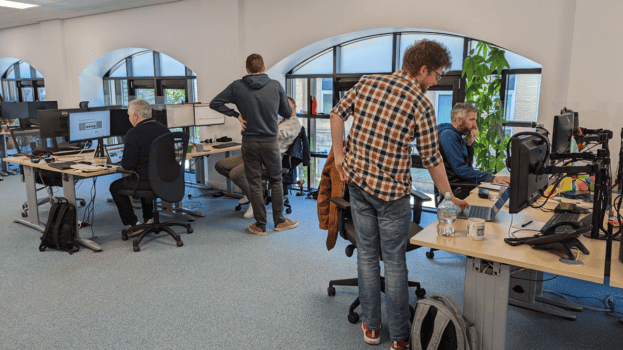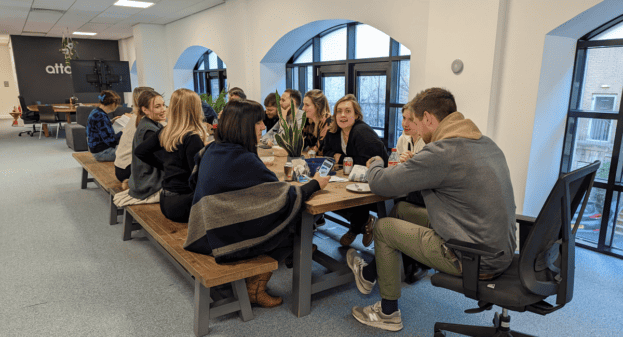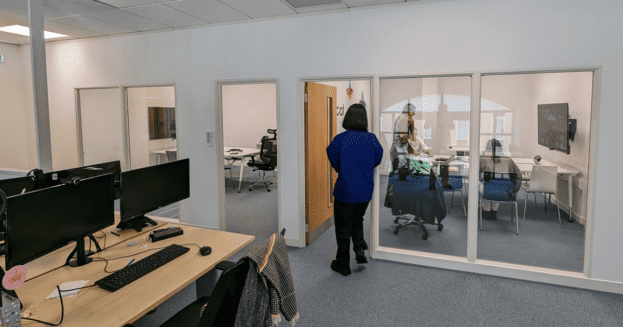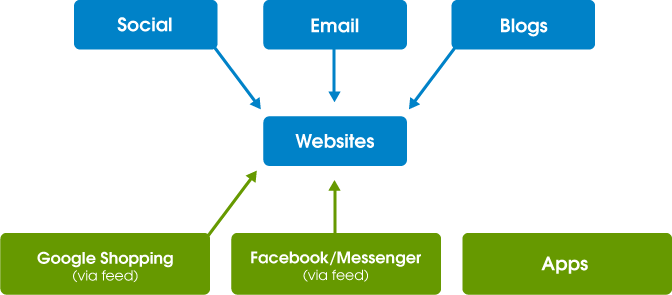How can you tell if your GA4 set-up is collecting all the information you are going to need for your ecommerce site? A great place to start is to compare your “Event report” to the list of Google Analytics “events” below.
(This is step two in our Eight point checklist for GA4 that we shared in our recent Getting ready for GA4 webinar.)
Why understanding your events is important
An event is simply any interaction on your site that GA4 records for you.
If you know what is being recorded, then you’ll be able to:
- interpret your GA4 reports
- understand what your GA4 set-up can report on, even if there isn’t a report already set-up for it.
Importantly if you can’t see any of the events below in your GA4 event report, then your GA4 will not be able to report on it for you.
It’s also worth bearing in mind that you’ll only be able to report on an event from the date you start collecting it. So it’s good to think about what you might also want to report on in the future when deciding what events to configure.
Seeing your events
Simply go to your “Events report” in GA4 by going to Reports > Engagement > Events)).
Make sure you can see all the following in your report:
You may also want some or all of the below set up too:
Only able to see a small portion of the above events?
(Warning. Build up to the sales pitch!)
You are not alone! There is a common view that GA should just work. This is not helped by Google saying they will set your GA4 property up automatically for you.
GA has never been a “does everything straight out of the box product”. It does, and always has, required a lot of technical configuration to take full advantage of its capabilities. So if you can’t see those events, and want to be able to report on them, you will need to get them configured.
Whilst some web developers may be able to do it for, our experience is that it’s not something they have the specialist knowledge to do well. That’s really not surprising given the number of bases a modern web dev needs to be able to cover.
GA configuration requires a very specific combination of marketing and technical skills. It also requires some pretty forensic levels of testing and issue resolution to make sure you are not only recording the data you need, but that you are also recording it accurately and in a privacy-compliant way.
So can Attacat help?
Well yes. Seeing you asked 😊
Save a fortune on your office rent by using ours when we aren’t using it!
The Stack on McDonald Road EH7 4QL
Our open plan office is located just off Leith Walk – a 15 minute walk from Waverley Station and a 5 minute walk from the tram which opens on 7 June.

It has 20+ desks and meeting rooms – all with docking stations so you just need to bring your laptops and plug in!
It is bright, airy and has plenty of communal and break-out spaces. There is also a shower, bike store and some parking (by arrangement). It is DDA compliant.

Since Covid and moving to a hybrid work pattern, we don’t occupy it 5 days a week and so it makes sense to see if another business could use it for either 2 or 3 days a week. It has a happy and vibrant atmosphere but we are just not using it to its full potential and so would be happy to share with a like-minded organisation.

The all-inclusive cost is £2,400 + VAT per month (equates to just £120/desk/month) and that includes rent, rates, service charge, utilities and equipment. This price is based on you taking the Monday and Friday but, for the right offer, we would also consider moving some or even all of our days. So a 3-day-a-week occupancy could be made to work.
If this is of interest to you, then please speak to Tim or drop us an email at office@attacat.co.uk

Last week, with time fast running out, ahead of the old Google Analytics sunset, we ran a webinar about the new version, GA4.
It’s very much our view, that Google’s claim to automatically set-up GA4 “for you based on your current settings” is going to lead to trouble for many. Certainly the automatic transfers we’ve seen, have very limited functionality.
And that’s why I shared this checklist at the end of the webinar:
- Consent in place?
- Are all the events I need being reported?
- Are my conversions set and grouped for easy reporting?
- Are the numbers the same as GA3 (or differences understood)?
- Users, sessions, page views
- Revenue, transactions and other conversions
- Channel splits
- Is everything I regularly look at in the standard reports?
- Do I understand the language of the new reports?
- Google Ads switched to GA4 conversions with necessary data?
- Is my data being retained (BigQuery)?
There are many GA4 checklists out there, but this is designed for the specific purpose of helping you to get in good shape ahead of the deadline on 30th June.
It’s based on the assumption that at this stage you:
- only want to use GA4 for your website; and
- are predominantly interested in getting it to take over the job GA3 is doing for you currently
- want to avoid a disruption to your Google advertising
That’s clearly not using GA4 to its full potential, but, for most, that is a conversation for another day.
To answer each of the above eight questions, you do need to have, or need to develop, a good understanding of things. So, if you missed the webinar, don’t worry, you can still watch it.
You may have heard us recommending Google Consent Mode as part of your measurement set-up.
So, what is Google Consent Mode (GCM)?
If you are intrigued to know more, here’s a brief layman’s introduction.
If you’d like to learn more then click on the calendar to make an appointment.
What is Google Marketing Live?
Once a year Google holds an annual jamboree for marketing professionals and agencies. It has now evolved into a global hybrid online/offline event. You can still watch all the keynotes and breakout sessions at your leisure.
Why it’s important
There are product announcements galore to excite any digital marketing geek, but for me it’s a must watch event as it gives an important insight into not only what is new but also the likely future direction of travel. For this reason we always forensically digest each session whilst reading the tea leaves so we can advise clients on what they need to be investing in.
What were the key themes?
Privacy (aka measurement and personalised advertising in a post-cookie world), Ad Automation (both of targeting and creative) and search becoming a more visual and sticky experience.
What should we be investing in as a result?
As ever you are probably already thinking about or doing all the below to some extent. This is simply a rallying cry to prioritise these investments.
Lifestyle to label imagery
Outstanding imagery is going to pay dividends both in organic and paid search and auto-generated display ads.
Search results
Google showcased a much more visual search results page – something that one of the Attacat team described as Pinterest-esque. This is a huge departure from the ten blue link text only experience of old and is part of Google’s move to keep searchers on Google for longer by providing a much fuller experience.
Paid shopping results will feature prominently and for the first time it looks as if organic shopping results will also get regular results page billing. Images from your pages may also be included in the standard organic listings.
Automatically generated creative
With respect to ads, there is a lot coming in terms of the automatic generation of display ads. Whilst this has been occurring for a while, big steps are being taken to make these autogenerated creatives attractive and onbrand. At the same time it is increasingly unrealistic to manually create all the formats and variations of ads needed to create tailored experiences at the different stages of the customer journey
So having unique and high quality images will be key to performing well. What can you do to visually showcase your products in a way that outperforms your competitors? We think having lifestyle imagery and images of every angle and detail right down to the label is now a must. Video, 360s and augmented reality capability in addition would be ideal.
(Side note – Ensuring the health of all other aspects of your product feed continues to become increasingly important.)
Be prepared to retool your measurement infrastructure
Getting ready for a post cookie world was a core theme. Accuracy of measurement will suffer without investment in new cookie-free technology. Google has been doubling down on providing this and for the first time I came away from a Google event thinking there is now an increasingly clear strategy for dealing with GDPR as opposed to the shoulder shrugs of a few years ago.
Google Analytics 4 (GA4) is obviously a key plank in the strategy. We’ve spent a lot of time lately focusing on the move to GA4 and it isn’t a straightforward process. Google Marketing Live confirmed that as well as highlighting that the required move is also bigger than just GA4. There is a whole raft of products (including server-side tagging and consent mode) that Google are investing in that are going to become pre-requisites for success.
These are deeply technical products that require technical, marketing, advertising and privacy heads to come together to deploy effectively. Making it work is much more complex and therefore a bigger investment than the measurement tools we’ve relied on to date.
For many it will be a forced reluctant investment as there is no choice but to do it. In the long run, I’m confident that it will bring some serious advantages and capabilities that we haven’t previously had. Either way I’m afraid a significant portion of budget over the next 12 months needs to be put aside for this move.
Invest in a Customer Relationship Management (CRM) system
You can’t have missed the “first party data” chat of the last year or two. Everyone knows that owning data about your customers is becoming increasingly important as cookies continue to crumble. A highly simplified way to conceptualise it, when Google talks about first party data, is “Google Analytics 4 plus a CRM”.
I came away feeling that a CRM should now be viewed as a principal part of the Google Advertisers toolset in the same way that we used to see conversion tracking as a non-negotiable part of Google Ads/PPC management.
The geeky bit that made me think that:
- There was huge emphasis on Customer Match throughout the event.
- Enhanced Conversions are also being seen as a key part of robust post-cookie measurement as well as for ad automation.
- HubSpot have been working with Google on a native integration which I’m sure will save our clients a lot of time.
Other thoughts
The benefits of utilising a standardised rather than a custom ecommerce system continue to increase. Many of Google’s products are increasingly available first to businesses on platforms like Shopify, usually with tick box integration as opposed to requiring custom coding.
Google is also clearly eyeing up Amazon’s product search market share and thinking about keeping shoppers on Google for longer. It may not be all that long before your customers will purchase from you without ever leaving Google as they do today on Amazon. In the meantime they showcased deeper linking into the shopping journey (e.g. add to basket buttons). Having an ecommerce platform that will keep up with these changes will be increasingly important.
Whilst on ecommerce platforms, Google wants you to think in terms of a “One shop” mentality i.e. fully connecting your offline and online shops in relation to stock, customer data and experience
Google offering searches the chance to message you directly from the results page is a wake up call to any company whose customer service is still in the email-only paradigm. Realtime messaging is now the expected norm.
An additional present Google is giving us is automated insight generation. Their hope of course is we use these insights to provide better assets for their algorithms to digest and create better ad experiences with. However the insights will no doubt be applicable to other channels and business strategy in general. “Break down the silos” was a repeated mantra of this years event – yes PPC and organic teams need to work together but it shouldn’t stop there, management, product designers, buyers and merchandisers all stand to benefit from the insights.
This is a letter I have emailed to our local MPs, MSPs, the Home Office and Kevin Foster MP (Minister for Safe and Legal Migration) this morning.
Please make it as easy as possible for employers to sponsor Ukrainian workers
Many, including me, share the sense of dismay that the UK is appearing so unwelcoming to Ukranian refugees. There can be no justification for it.
The Ukrainian population is incredibly well educated and many have a fantastic command of the English language. Frankly we should be doing everything we can to encourage them to come here, given how much they could contribute. Given the labour shortages the UK is facing, there has to be a win-win here.
To that end, please can you do everything in your power to ensure that the flyered, but not yet available, sponsorship route will be as easy as possible for small employers to use so they can offer jobs to refugees for any job. With a job secured, housing and all other support required would take care of itself with only a positive effect for the UK.
The current employment sponsorship program will be totally inappropriate for this situation. As a small business owner, I have sponsored an employee previously and the whole process was a bureaucratic nightmare. There are many jobs where there are employers crying out for talent that fall in between menial seasonal work and skilled roles defined as being in short supply. Removing those restrictions would make it much easier for employers to make a contribution to the current crisis.
The ideal however would be if I were simply allowed to put anyone with a Ukrainian passport on my payroll.
If I can provide any more information that would help you make such a case in Parliament, please don’t hesitate to ask.
Your faithfully
Tim Barlow
Managing Director
Attacat Ltd
If January is a time to tackle what you keep putting off such as losing weight or getting fit, then what better time to get your digital marketing approach to privacy sorted out. The good news is that it isn’t as hard as you think.
Here we set out a handful of simple(ish!) steps to ensure you have a consent process in place for the three digital marketing cornerstones that most businesses rely on, namely:
- Analytics
- Digital advertising
- Email marketing (which is readily adaptable to other direct digital marketing such as chat, push notifications and SMS)
The topic of online privacy is not helped by buzzwords. It’s not helped by cookies and privacy being seen as separate “projects”. It’s also not helped by falling across the separate silos of law, IT and marketing or by GDPR’s complexity and flaws.
However expectations and enforcement are ramping up. And people posing as privacy activists are also seeing non-compliant businesses as an opportunity to ask for money. With the law probably on their side, the costs of dealing with non-compliance are increasingly outweighing the costs of getting your house in order.
As a minimum, it now makes sense to take some sensible steps to avoid being among the easiest targets. It is also becoming clear that a good portion of now standard analytics and advertising techniques, will only be available to businesses able to get and prove that they have “consent”.
Here are five steps that we think everyone should now be taking:
- Get a “Do not pass go” cookie banner that actually works
- Put clear privacy information wherever you collect email addresses and get a linked “preference centre”
- Make risk-based decisions on your approach to targeted advertising and analytics
- Draw up a privacy policy that is known and understood by management and customer facing teams
- Implement automated deletion of out of date contact information
1. Get a “Do not pass go” cookie banner that actually works
Our suggested approach to cookie consent is to make customers take a decision before they can use the site (i.e. an overlay banner). This is all very achievable with a low-cost consent management tool.
What these tools don’t advertise though is that they rarely work out of the box, despite suggestions to the contrary. The user interface will work but the actual placing (or otherwise) of cookies almost always needs a lot of configuring before it does what you expect it to do (i.e. respect the choices your customers make). As a result many companies now have banners that aren’t actually doing what management think they are doing!
The configuring part, which we usually do in Google Tag manager, does need ongoing management as things will “break” or get out of date over time. Yes it’s a process that needs putting in place but it is perfectly doable.
2. Put clear privacy information wherever you collect email addresses and get a linked “preference centre”
The days of assuming that you can do whatever you like with an email address, even one given voluntarily, are over. Instead you need to get permissions for specific purposes (e.g. marketing). The place to do this is the point at which you are given the email address (i.e. the form on your site or app).
Having got permission, you then need to make it easy for permissions to be updated. Rather than just a simple unsubscribe option, a “preference centre” is a better option. All this is a single destination on your site where customers can decide exactly what messages they do and don’t want to receive from you.
Although doing this well (maximizing consent whilst genuinely respecting privacy) requires a clear strategy and attention to detail, technology is finally making it doable. If you are using a tool like HubSpot these consent features will now be built in.
The point, is the ability to do all this is now within the reach of most businesses, which wasn’t the case two years ago.
3. Make risk-based decisions on your approach to targeted advertising and analytics
The first part of this is to understand what analytics and advertising your business is currently involved in. Even use of standard products such Google Analytics, Google Ads and Facebook Ads have quite significant privacy implications.
At its simplest, we suggest getting to answers for the following questions:
- How explicit a consent do we need for Analytics?
- Every company will have different red lines on these questions. You will need to debate them and then draw up a policy..
4. Draw up a privacy policy that is known and understood by management and customer facing teams
It’s easy enough to help yourself to someone else’s privacy policy and put it on your site and pretend all is in hand! However privacy policies today need to be specific to each business rather than the generic ones of old. They need to truly reflect the intricacies of your business and they need to evolve as your business evolves. They should be living documents that are seen as an important part of the customer experience.
Management being involved in the above steps will go a long way to understanding the privacy implications of your marketing activity. Our view is to write the first draft of the policy as a team and only once that is done, get the lawyers to take a look. This will have two primary benefits:
- It will increase understanding across your teams
- It will result in something more customer friendly
5. Implement automated deletion of out of date contact information
Old forgotten about contact information in your systems is a risk. Being proactive about cleaning up data routinely will also deliver a better marketing result. Most modern CRM systems will allow you to set-up automated rules so you can delete information on sensible timelines (and ones tailored to different situations e.g. you’d retain a contact for longer if they have made a purchase than you would if they have never purchased and don’t interact with any of your content).
As with all the other steps, debating and agreeing the right approach for your business is the starting point.
Summary
Doing the above certainly does not guarantee full compliance. Hopefully though they are achievable steps that businesses can make a firm part of their early 2022 plans. We urge you to make this a key New Year’s resolution and of course would be happy to help you on that journey. If you would like to schedule a meeting to discuss any of the above please select an available date from the calendar>>
In the meantime, fingers crossed for a great, uninterrupted, Christmas!
It’s been a pretty long and tough six months for everyone.
To that end we have decided that closing the “office” for two days next Thursday and Friday will be to everyone’s benefit. I would be extremely grateful for your (our clients’) support of this attempt to give the team a break from the screens they have been glued to.
Unlike most agencies, we took a decision back at the beginning of lockdown to not furlough the team. We felt that “if ever there was a time our clients needed us, it’s now”.
And thanks to our client’s support and a huge amount of hard work from the entire team, our business and the vast majority of our clients have muddled through lock-down in reasonable shape. We’ve dealt with the surge in ecommerce and all the uncertainty of the ever changing challenges of the gradual reopening of the economy. And we’ve learned a lot too!
It seems that the country is currently enjoying a degree of normality and I’m keen that the team get a bit of a chance to enjoy this right now just in case, heaven forbid, life becomes more restricted again.
I also want to find a way of saying thank you to the team by giving them an extra couple of days off. I’m obviously biased but we have an incredible team and they really deserve some recognition of that.
Sometimes getting people to take time off requires a bit of a nudge. The team have been incredibly resilient but I want to be sure everyone manages to down tools and ideally get a proper change of scenery for a few nights. If like me, you have managed to get away (anywhere!) this summer you will know what a difference it makes.
So that’s why I’ve chosen fixed dates rather than just adding to an unused holiday pile.
I would therefore like to ask our clients to please:
- Highlight any potential challenges with these two days as soon as possible so we can put a plan in place
- Have a think about what work you may need us to do before the end of next Wednesday
- Support the break as best as you can (your account manager will be in touch with emergency contact methods but I’d obviously be incredibly grateful if you do your best not to use it 🙂
Obviously everything will be left in good shape on Wednesday night and those critical things that need looking after, will be looked after.
Thank you in advance for your support on this and of course all the support you have shown us throughout this period.
The way many organisations plan their online presence today still looks something like this:

Interactions on all channels have the sole purpose of pointing prospects back to the company website, driving them through the funnel in just one location.
But if prospects are happy where they are, why are we so insistent on moving them? Why not communicate with consumers where and how they choose to, not how our technology ‘permits’ them?
You’ve probably started doing this without giving it much thought. For example you’ve probably added third party sites, such as Google Shopping and Facebook, into the mix over time.

Yet these platforms are increasingly becoming product destinations in their own right. It doesn’t take much imagination to add in Facebook and Google Pay and suddenly our customer will no longer bother even touching our websites.
And these platforms are multiplying. You just get to grips with three and then another three appear.
So how on earth can we keep up? The answer – by intelligently pushing out data to all channels from just one centralised source.

By creating a data platform that feeds into all the online platforms, we will give users messages (or the much fabled ‘micro-moments’) within the platforms they reside, rather than trying to drive them away to our sites or apps. Google Shopping, Amazon, Facebook ads, websites, social media, email and messaging platforms are just some of the media that stand to benefit from such an approach – presenting opportunities we can’t afford to ignore.
And how often have you said “Alexa…” recently? If it isn’t yet part of your daily life, it, or something similar will be soon.
Forget Product Pages
In the context of e-commerce, what we should consider is not just product pages but platform agnostic product data. The key is to design a data source for life beyond the product page i.e. think far wider than the traditional e-commerce CMS.
By data I mean all content and attributes (images, stock levels, product title, short description, long description, attributes etc.) so they all have the potential to be stored centrally and distributed intelligently across all platforms.
Forget Page Optimisations
Most CMSs already have integrations with third party apps such as Google Shopping, but these so often remain unoptimised. Time and again we’ve seen dramatically increased revenues from optimising these feeds. Very much like you do with optimising web pages.
The overlap between Google shopping optimisation for AdWords and product page optimisation for organic SEO is huge. It’s much better to approach that as a single task at the “data” level, rather than doing one task at the page level and another at the feed level.
I really enjoyed the recent MozPod interview on Amazon’s SEO ranking factors with Connor Folley of Downstream. He emphasised just how vital it is to tailor both your data and approach to third party retailer sites. An increase in work for retailers we hear you ask? Enter platform agnostic product data…
A centralised data platform could tailor data to Amazon’s specific ranking criteria. All as part of one optimisation process.
Beyond Retail

Being present on multiple platforms doesn’t just apply to e-commerce. Rather than thinking about product data, we can think about “communication data” or perhaps just “messaging.” We need a way of distributing our messages from a central source.
The interesting thing about messages is that they tend to have a much more temporal nature. With product data we can get away with just planning over space. With messaging though we need to to plan over both time and space to create an ongoing experience. Good fun!
Closing Thoughts
It’s time to stop thinking about websites first. We need to take a step back and think “multi-platform.” Reorienting the way we plan our online presence in this way will help to ensure that we are where the customer wants us to be. Let’s stop pushing water uphill. We don’t always need to get customers to come to us.